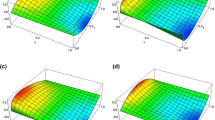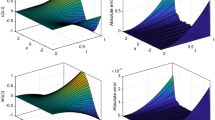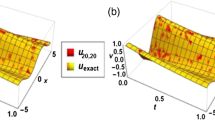Abstract
In this paper, a new fractional physics-informed neural networks (fPINNs) is proposed, which combines fPINNs with spectral collocation method to solve the time-fractional phase field models. Compared to fPINNs, it has large representation capacity due to the property of spectral collocation method, which reduces the number of approximate points of discrete fractional operators, improves the training efficiency and has higher error accuracy. Unlike the traditional numerical method, it directly optimizes the spectral collocation coefficient, saves the time of matrix calculation, is easy to deal with the high-dimensional model, and also has higher error accuracy. First, fPINNs based on a spectral collocation method is used to obtain the numerical solutions of the models under consideration. The spectral collocation method is used to discretize the space direction, and the fractional backward difference formula is used to approximate the time-fractional derivative. The error accuracy in different cases is discussed, and it is observed that the point-wise error is \(10^{-5}\) to \(10^{-7}\). Next, fPINNs is employed to solve several inverse problems in time-fractional phase field models to identify the order of fractional derivative, mobility constant, and other coefficients. The results of numerical experiments are presented to prove the effectiveness of fPINNs in solving time-fractional phase field models and their inverse problems.






















Similar content being viewed by others
Data availability statement
The datasets generated and analyzed during the current study are available from the corresponding author on reasonable request.
References
Brunton, S., Proctor, J., Kutz, J.: Discovering governing equations from data by sparse identification of nonlinear dynamical systems. Proc. Nat. Acad. Sci. 113(15), 3932–3937 (2016)
Brunton, S., Noack, B., Koumoutsakos, P.: Machine learning for fluid mechanics. Annu. Rev. Fluid Mech. 52, 477–508 (2020)
Gao, G., Li, J., Wen, Y.: DeepComfort: energy-efficient thermal comfort control in buildings via reinforcement learning. IEEE Internet Things J. 7, 8472–8484 (2020)
Bouman, K., Xiao, B., Battaglia, P., Freeman, W.: Estimating the material properties of fabric from video. In: Proceedings of the IEEE International Conference on Computer Vision. 1984–1991 (2013)
Zhao, R., Yan, R., Chen, Z., Mao, K., Wang, P., Gao, R.: Deep learning and its applications to machine health monitoring. Mech. Syst. Signal Process. 115, 213–237 (2019)
Wang, Q., Zhang, G., Sun, C., Wu, N.: High efficient load paths analysis with U index generated by deep learning. Comput. Methods Appl. Mech. Eng. 344, 499–511 (2019)
Finol, D., Lu, Y., Mahadevan, V., Srivastava, A.: Deep convolutional neural networks for eigenvalue problems in mechanics. Internat. J. Numer. Methods Eng. 118(5), 258–275 (2019)
Karpatne, A., Atluri, G., Faghmous, J., Steinbach, M., Banerjee, A., Ganguly, A., Shekhar, S., Samatova, N., Kumar, V.: Theory-guided data science: a new paradigm for scientific discovery from data. IEEE Trans. Knowl. Data Eng. 29(10), 2318–2331 (2017)
Raissi, M., Perdikaris, P., Karniadakis, G.: Physics-informed neural networks: a deep learning framework for solving forward and inverse problems involving nonlinear partial differential equations. J. Comput. Phys. 378, 686–707 (2019)
Kharazmi, E., Zhang, Z., Karniadakis, G.: hp-VPINNs: variational physics-informed neural networks with domain decomposition. Comput. Methods Appl. Mech. Eng. 374(C), 113547 (2021)
Pang, G., D’Elia, M., Parks, M., Karniadakis, G.: nPINNs: nonlocal physics-informed neural networks for a parametrized nonlocal universal Laplacian operator. Algorithms Appl. J. Comput. Phys. 422, 109760 (2020)
Jagtap, A., Karniadakis, G.: Extended physics-informed neural networks (XPINNs): a generalized space-time domain decomposition based deep learning framework for nonlinear partial differential equations. Commun. Comput. Phys. 28(5), 2002–2041 (2020)
Zheng, Q., Zeng, L., Karniadakis, G.: Physics-informed semantic inpainting: application to geostatistical modeling. J. Comput. Phys. 419, 109676 (2020)
Giusti, A.: A comment on some new definitions of fractional derivative. Nonlinear Dyn. 93, 1757–1763 (2018)
Wu, G., Baleanu, D.: Discrete fractional logistic map and its chaos. Nonlinear Dyn. 75, 283–287 (2014)
Benson, D., Wheatcraft, S., Meerschaert, M.: Application of a fractional advection-dispersion equation. Water Resour. Res. 36, 1403–1412 (2000)
Sun, H., Zhang, Y., Chen, W., Reeves, D.: Use of a variable-index fractional-derivative model to capture transient dispersion in heterogeneous media. J. Contam. Hydrol. 157, 47–58 (2014)
Sun, H., Zhang, Y., Chen, W., Reeves, D.: Use of a variable-index fractional-derivative model to capture transient dispersion in heterogeneous media. J. Contam. Hydrol. 157, 47–58 (2014)
Chen, W., Holm, S.: Fractional laplacian time-space models for linear and nonlinear lossy media exhibiting arbitrary frequency power-law dependency. J. Acous. Soc. Amer. 115, 1424–1430 (2004)
Chen, W.: A speculative study of 2/3-order fractional laplacian modeling of turbulence: some thoughts and conjectures. Chaos 16, 023126 (2006)
Sirignano, J., Spiliopoulos, K.: DGM: a deep learning algorithm for solving partial differential equations. J. Comput. Phys. 375, 1339–1364 (2018)
Berg, J., Nystr\(\ddot{o}\)m, K.: A unified deep artificial neural network approach to partial differential equations in complex geometries. Neurocomputing 317, 28–41 (2018)
Meng, X., Li, Z., Zhang, D., Karniadakis, G.: PPINN: parareal physics-informed neural network for time-dependent PDEs. Comput. Methods Appl. Mech. Eng. 370, 113250 (2020)
Pang, G., Lu, L., Karniadakis, G.: fPINNs: fractional physics informed neural networks. SIAM J. Sci. Comput. 41, 2603–2626 (2019)
Rostami, F., Jafarian, A.: A new artificial neural network structure for solving high-order linear fractional differential equations. Int. J. Comput. Math. 95(3), 528–539 (2018)
Hajimohammadi, Z., Baharifard, F., Ghodsi, A.: Fractional chebyshev deep neural network (FCDNN) for solving differential models. Chaos Solitons Fractals 153(2), 111530 (2021)
Qu, H., Liu, X., She, Z.: Neural network method for fractional-order partial differential equations. Neurocomputing 414, 225–237 (2020)
Rasanan, A., Bajalan, N., Parand, K., Rad, J.: Simulation of nonlinear fractional dynamics arising in the modeling of cognitive decision making using a new fractional neural network. Math. Meth. Appl. Sci. 43(3), 1437–1466 (2020)
Kapustina, M., Tsygankov, D., Zhao, J., Wesller, T., Yang, X., Chen, A., Roach, N., Elston, T., Wang, Q., Jacobson, K., Forest, M.: Modeling the excess cell membrane stored in a complex morphology of bleb-like protrusions. Plos Comput. Biol. 12(3), 1004841 (2016)
Shao, D., Pappel, W., Levine, H.: Computational model for cell morphodynamics. Phys. Rev. Lett. 105(10), 108104 (2010)
Ziebert, F., Aranson, I.: Effects of adhesion dynamics and substrate compliance on the shape and motility of crawling cells. Plos One 8(5), 64511 (2013)
Zhao, J., Shen, Y., Happasalo, M., Wang, Z., Wang, Q.: A 3D numerical study of antimicrobial persistence in heterogeneous multi-species biofilms. J. Theor. Biol. 392, 83–98 (2016)
Kohn, R., Yan, X.: Upper bound on the coarsening rate for an epitaxial growth model. Comm. Pure Appl. Math. 56(11), 1549–1564 (2003)
Li, B., Liu, J.: Epitaxial growth without slope selection: energetics, coarsening and dynamic scaling. J. Nonlinear Sci. 14(5), 429–451 (2004)
Allen, S., Cahn, J.: A microscopic theory for antiphase boundary motion and its application to antiphase domain coarsening. Acta Metall. Mater. 27(6), 1085–1095 (1979)
Doi, M., Edwards, S.: The Theory of Polymer Dynamics, p. 73. Oxford University Press, Oxford (1988)
Cahn, J., Hilliard, J.: Free Energy of a Nonuniform System. I. Interfacial Free Energy. J. Chem. Phys. 28, 258–267 (1958)
Yue, P., Feng, J., Liu, C., Shen, J.: A diffuse-interface method for simulating two-phase flows of complex fluids. J. Fluid Mech. 515, 293–317 (2004)
Anderson, D., Mcfadden, G., Wheeler, A.: Diffuse-interface methods in fluid mechanics. Annu. Rev. Fluid Mech. 30, 139–165 (1997)
Ainsworth, M., Mao, Z.: Analysis and approximation of a fractional Cahn–Hilliard equation. SIAM J. Numer. Anal. 55(4), 1689–1718 (2017)
Ainsworth, M., Mao, Z.: Well-posedness of the Cahn–Hilliard equation with fractional free energy and its Fourier Galerkin approximation. Chaos Soliton. Fract. 102, 264–273 (2017)
Akagi, G., Schimperna, G., Segatti, A.: Fractional Cahn–Hilliard, Allen–Cahn and porous medium equations. J. Differ. Equ. 261(6), 2935–2985 (2016)
Zhao, J., Chen, L., Wang, H.: On power law scaling dynamics for time-fractional phase field models during coarsening. Commun. Nonlinear Sci. Numer. Simulat. 70, 257–270 (2019)
Zhen, G., Lowengrub, J., Wang, C., Wise, S.: Second order convex splitting schemes for periodic nonlocal Cahn-Hilliard and Allen-Cahn equations. J. Comput. Phys. 277, 48–71 (2014)
Zhang, H., Jiang, X.: A high-efficiency second-order numerical scheme for time-fractional phase field models by using extended SAV method. Nonlinear Dyn. 102, 589–603 (2020)
Liu, Z., Li, X., Huang, J.: Accurate and efficient algorithms with unconditional energy stability for the time fractional Cahn–Hilliard and Allen–Cahn equations. Numer. Methods Partial Differ. Equ. 37(3), 2613–2633 (2021)
Antil, H., Baetrls, S.: Spectral approximation of fractional PDEs in image processing and phase field modeling. J. Comput. Methods Appl. Math. 17(4), 661–678 (2017)
Liu, H., Cheng, A., Wang, H., Zhao, J.: Time-fractional Allen-Cahn and Cahn-Hilliard phase-field models and their numerical investigation. Comput. Math. Appl. 76(8), 1876–1892 (2018)
Song, F., Xu, C., Karniadakis, G.: A fractional phase-field model for two-phase flows with tunable sharpness: Algorithms and simulations. Comput. Methods Appl. Mech. Engrg. 305, 376–404 (2016)
Wu, B., Chen, Q., Wang, Z.: Uniqueness and stability of an inverse problem for a phase field model using data from one component. Comput. Math. Appl. 66, 2126–2138 (2013)
Baranibalan, N., Sakthivel, K., Balachandran, K., Kim, J.: Reconstruction of two time independent coefficients in an inverse problem for a phase field system. Nonlinear Anal. 72, 2841–2851 (2010)
Colombo, F.: Direct and inverse problems for a phase-field model with memory. J. Math. Anal. Appl. 260, 517–545 (2001)
Khodadadian, A., Noii, N., Parvizi, M., Abbaszadeh, M., Wick, T., Heitzinger, C.: A Bayesian estimation method for variational phase-field fracture problems. Comput. Mech. 66(4), 827–849 (2020)
Bandai, T., Ghezzehei, T.: Physics-informed neural networks with monotonicity constraints for Richardson–Richards equation: estimation of constitutive relationships and soil water flux density from volumetric water content measurements. Water Resour. Res. 57(2), 20 (2021)
Ruder, S.: An overview of gradient descent optimization algorithms. arXiv:1609.04747v2 (2016)
Huisman, M., van Rijn, J., Plaat, A.: A survey of deep meta-learning. Artif. Intell. Rev. 54(6), 4483–4541 (2021)
Funding
This study was funded by the National Natural Science Foundation of China (grant number 12120101001, 12001326), Natural Science Foundation of Shandong Province (grant number ZR2020QA032), and China Postdoctoral Science Foundation (grant number BX20190191, 2020M672038).
Author information
Authors and Affiliations
Corresponding author
Ethics declarations
Conflict of Interest
The authors declare that they have no conflict of interests regarding the publication of this paper.
Additional information
Publisher's Note
Springer Nature remains neutral with regard to jurisdictional claims in published maps and institutional affiliations.
Rights and permissions
Springer Nature or its licensor holds exclusive rights to this article under a publishing agreement with the author(s) or other rightsholder(s); author self-archiving of the accepted manuscript version of this article is solely governed by the terms of such publishing agreement and applicable law.
About this article
Cite this article
Wang, S., Zhang, H. & Jiang, X. Fractional physics-informed neural networks for time-fractional phase field models. Nonlinear Dyn 110, 2715–2739 (2022). https://doi.org/10.1007/s11071-022-07746-3
Received:
Accepted:
Published:
Issue Date:
DOI: https://doi.org/10.1007/s11071-022-07746-3




